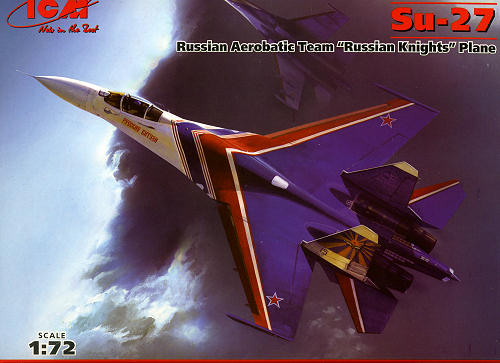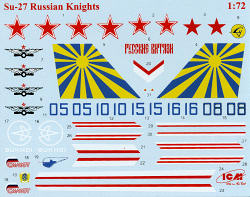
ICM 1/72 Su-27 'Russian Knights'
| KIT #: | 72223 |
| PRICE: | 39.00 MSRP |
| DECALS: | One option |
| REVIEWER: | Scott Van Aken |
| NOTES: |

| HISTORY |
The Sukhoi Su-27 (Сухой Су-27 in the Cyrillic alphabet) (NATO reporting name ‘Flanker’) is a one-seat Mach-2 class jet fighter plane originally manufactured by the Soviet Union, and designed by the Sukhoi Design Bureau. It was intended as a direct competitor for the large American fourth generation fighters, with long 3,530 km range, heavy armament, sophisticated avionics and high agility. The Su-27 most often flies air superiority missions, but is able to perform almost all combat operations. Complementing the smaller MiG-29, its closest American counterpart is the F-15 Eagle.
There are several related developments of the Su-27 design. The Su-30 is a two-seat, dual-role fighter for all-weather, air-to-air and air-to-surface deep interdiction missions; comparable to F-15E Strike Eagle. Su-33 ‘Flanker-D’ is a navy fleet defense interceptor for use on aircraft carriers; comparable to F/A-18E/F Super Hornet. Further versions include the side-by-side 2-seat Su-34 ‘Fullback’ strike variant and the Su-35 ‘Flanker-E’ improved air defense fighter.
The Russian Knights aerobatic team was created on April 5, 1991 and manned by the best pilots of the Kubinka Air Force base, who had fully mastered the piloting of the 4th generation Su-27 fighter. The team is organic to the Russian Air Force 237th Aircraft Demonstration Centre named after Air Force Marshal Ivan Kozhedub (Russian acronym - TsPAT).| THE KIT |
 ICM has become known for producing some very nice kits of modern Russian aircraft over the years, and one can add into that mix, this Su-27 'Flanker'. Enthusiasts of this sort of plane can spot the variant better than I, but it appears to be the base model Flanker A. The Flanker has been kitted before by Hasegawa in this scale and since it is a large aircraft, it was also quite pricey for the time. Even in today's money, cheap it is not, but you do get a lot of plastic for your loot.
ICM has become known for producing some very nice kits of modern Russian aircraft over the years, and one can add into that mix, this Su-27 'Flanker'. Enthusiasts of this sort of plane can spot the variant better than I, but it appears to be the base model Flanker A. The Flanker has been kitted before by Hasegawa in this scale and since it is a large aircraft, it was also quite pricey for the time. Even in today's money, cheap it is not, but you do get a lot of plastic for your loot.
As you can guess, the detailing is all that we have come to expect from ICM and other companies who mold new kits. Engraved panel lines, and none of that 'rivet detail' that we get from some others, which is something I appreciate. One glitch I noticed is the the upper surface of the wings is not at all smooth. It has what look like sink areas all over the section closest to the fuselage. These are one-piece wings and the plastic is rather thick in this area, undoubtedly the culprit. When one pops a mold out of the machine too quickly, one gets these deformations and I'm betting that is what is happening. Filler and rescribing will take care of it or you can blow it off and mark it down to over-stressing the airframe.
Cockpit is fairly well apportioned with the usual tub, seat and instrument panel. Seat is fairly nicely done, but were I to spend additional money on this kit, I'd replace it with a nice resin one with much more detail. No side console detail, no main instrument panel detail and no decal to plunk in there so you are on your own.
The main and nose gear are nicely done and look complex enough to mass muster. The intakes look like they might require some careful construction, but at least, there isn't the long trunking that causes so much trouble on the MiG-29 and F-14 kits. The canopy and speedbrake can be finished in the open position should you wish. A multitude of weaponry is included and from what I can tell, the missiles are well formed and what one would find on this plane. Two of the sp rues are dedicated to missiles and pylons. However, on this boxing, those will be confined to the spares box for the most part as only a single item from each missile sprue will be used on this kit. Now if you decide to build a standard interceptor, then you have all this stuff available to you though it won't be annotated in the instructions.
rues are dedicated to missiles and pylons. However, on this boxing, those will be confined to the spares box for the most part as only a single item from each missile sprue will be used on this kit. Now if you decide to build a standard interceptor, then you have all this stuff available to you though it won't be annotated in the instructions.
Instructions are fairly well done using the popular CAD style drawings. They are a tad dark but as all the parts are called out, assembly should not be an issue. Markings are for but a single aircraft from the display team. The sheet provides all the stripes and complex fin markings, but you will need to paint the large swaths of color that are found on the plane. The decal sheet is well printed and is in register, which is nice.
| CONCLUSIONS |
So now you have an alternative to the rather pricey and difficult to find Hasegawa kit. This one will take a bit of care and some modeling skills, but the end result will be a very nice model of an important Russian aircraft.
| REFERENCES |
January 2010
My thanks to www.dragonmodelsusa.com for the preview kit. Get yours at your local hobby shop or on-line retailer.
If you would like your product reviewed fairly and fairly quickly, please contact the editor or see other details in the